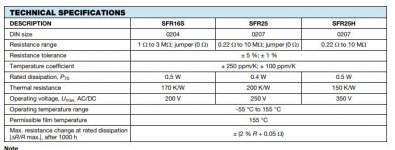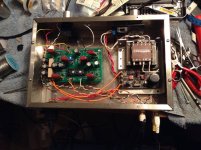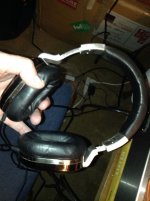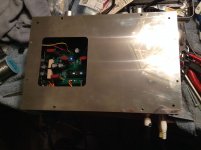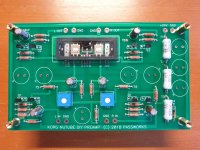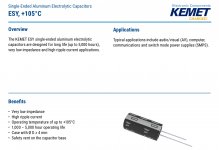OK, it's making music. At first, I attached headphone adaptor to outputs just to check and make sure there was through put. There seemed to be some intermittent crackling, but I can't tell yet if it lousy cables and connections to headphones.
However after a bit, it played music steadily through both channels. I used Ultrasone Edition 8 (36 ohms) and Sony Z7 (80 ohms). Impedance match isn't ideal, but the NuTube has plenty of gain with these to make sound louder than I want.
So, the JFETs survived my soldering skills and seem to be 'correct' as far as I can tell.
I would recommend for those still building to get the 10Kohm potentiometers that have more turns and sweep, as making fine adjustments is really touchy with the one turn model. I settled on 9.4 Volts for T7 and T8 after some warmup.
It sounds really nice using an ipod as source with compressed music and my patchwork headphone rig. It definitely sounds like 'tubes' rather than SS, quite lovely so far, but I am sure it needs some run in to optimize. I am also not using it for it's intended purpose with headphones, so I will try it later with a proper amplifier.
Very nice, Mr. Pass!
Oh, I put surgical silastic under the NuTube and also under the board. I also gave the power supply some degree of motion and have silastic under that, too. No microphonics so far either tapping on the tube, turn on, playing the music. I can't hear any noise with the volume turned all the way up and no source, but maybe it would be different with speakers.
However after a bit, it played music steadily through both channels. I used Ultrasone Edition 8 (36 ohms) and Sony Z7 (80 ohms). Impedance match isn't ideal, but the NuTube has plenty of gain with these to make sound louder than I want.
So, the JFETs survived my soldering skills and seem to be 'correct' as far as I can tell.
I would recommend for those still building to get the 10Kohm potentiometers that have more turns and sweep, as making fine adjustments is really touchy with the one turn model. I settled on 9.4 Volts for T7 and T8 after some warmup.
It sounds really nice using an ipod as source with compressed music and my patchwork headphone rig. It definitely sounds like 'tubes' rather than SS, quite lovely so far, but I am sure it needs some run in to optimize. I am also not using it for it's intended purpose with headphones, so I will try it later with a proper amplifier.
Very nice, Mr. Pass!
Oh, I put surgical silastic under the NuTube and also under the board. I also gave the power supply some degree of motion and have silastic under that, too. No microphonics so far either tapping on the tube, turn on, playing the music. I can't hear any noise with the volume turned all the way up and no source, but maybe it would be different with speakers.
Attachments
Last edited:
RN55 are 100% derated to meet a US Mil-spec.
That means that they are a 1/4w resistor that says 1/8W on the data sheet.
They are identical to CMF55 except the leads of the RN must be non-magnetic, where the CMF sometimes are steel, and the tinning on the leads is not lead-free, because the US milspec absolutely positively will never be lead-free, because they understand the metallurgy behind stable solder joints.
(Research “tin whiskers” for more data. Want to stop tin whiskers? Use leaded solder. 🙂 )
That means that they are a 1/4w resistor that says 1/8W on the data sheet.
They are identical to CMF55 except the leads of the RN must be non-magnetic, where the CMF sometimes are steel, and the tinning on the leads is not lead-free, because the US milspec absolutely positively will never be lead-free, because they understand the metallurgy behind stable solder joints.
(Research “tin whiskers” for more data. Want to stop tin whiskers? Use leaded solder. 🙂 )
Ho ho ho, I am almost there. Waiting for the Mouser delivery to complete the build.View attachment 741158
Haha. I am also awaiting the large capacitors. Strange.
RN55 are 100% derated to meet a US Mil-spec.
..except the leads of the RN must be non-magnetic..
Interesting thanks 6L6 for clarification 🙂 Greetings
I am also awaiting the large capacitors.
Kemet Company capacitors are long life 10000 or 5000 hours , low impedance, high ripple current
EST108M035AL4AA KEMET | Mouser France
https://www.mouser.fr/ProductDetail...=sGAEpiMZZMtZ1n0r9vR22XqtLh5sbTzGJXGU9nA/DVY=
Attachments
hello,
are those 10uf input output and grid capacitors have to be polarized?
or can it be replaced with mkp 10uf film caps?
thanks.
are those 10uf input output and grid capacitors have to be polarized?
or can it be replaced with mkp 10uf film caps?
thanks.
Apparently I'm using a different iteration of the PCB. It comes from the DiyAudio store...but what are all the slots for Jfet's for on mine?
View attachment 741202
You can use different JFets with your board. Look at the pinout. DSG versus DGS. If you've Toshibas then use the J- and if you've Fairchilds use the K-slots.
Greets,
Micha
Hey Kevin,
Papa has a revised doc for this version.
http://www.firstwatt.com/pdf/art_diy_nutube_preamp.pdf
"The PC board is set up to accommodate a variety of Jfets and has corresponding holes for
the parts, being that they have different pin-outs. The JQ1,Q2 is used for the Fairchild J113's
and the KQ1,Q2 fits the 2SK170, 2SK370, and LSK170 Jfets." (see page 3)
Also there is a trace missing in the V1R0 version of the PCB ( see p7):
Cheers,
Dennis
Papa has a revised doc for this version.
http://www.firstwatt.com/pdf/art_diy_nutube_preamp.pdf
"The PC board is set up to accommodate a variety of Jfets and has corresponding holes for
the parts, being that they have different pin-outs. The JQ1,Q2 is used for the Fairchild J113's
and the KQ1,Q2 fits the 2SK170, 2SK370, and LSK170 Jfets." (see page 3)
Also there is a trace missing in the V1R0 version of the PCB ( see p7):
Cheers,
Dennis
If you've Toshibas then use the J- and if you've Fairchilds use the K-slots.
Greets,
Micha
K slots for Toshiba
J for Fairchild 😉
Hey Kevin,
Papa has a revised doc for this version.
http://www.firstwatt.com/pdf/art_diy_nutube_preamp.pdf
"The PC board is set up to accommodate a variety of Jfets and has corresponding holes for
the parts, being that they have different pin-outs. The JQ1,Q2 is used for the Fairchild J113's
and the KQ1,Q2 fits the 2SK170, 2SK370, and LSK170 Jfets." (see page 3)
Also there is a trace missing in the V1R0 version of the PCB ( see p7):
Cheers,
Dennis
Also, page 6 parts list shows qty=2 100 ohm resistor. Qty=4 are required.
Earlier, I asked how people are implementing volume attenuation for this (I have the DIYAudio board/Fairchild transistors and matched resistors--thanks Nelson!). Since the signal input and output are simply signal and ground, I assume people are wiring in standard 3 pole potentiometers with just one end terminal of the pot and the wiper? Also assuming the pot goes on the input and RCA jacks on the output?...
Has anyone simply gone with RCA jacks at both input and output and used a separate preamp, and could speak to how they liked this setup?
Thanks;
limits
Has anyone simply gone with RCA jacks at both input and output and used a separate preamp, and could speak to how they liked this setup?
Thanks;
limits
I listened to my newly built Pass Korg NuTube last night. 40 year old Yamaha B-1 VFET amplifier, simple crossover-less panels full range. Speakers are probably about 88 db efficient. Bias on Pass Korg set to 94 V, which is in the range of the positive second order harmonics.
I'm trying to keep myself from a rave, but I have heard $500k systems that don't sound this good. The B-1 is already a hypnotic amplifier, but the Pass Korg opened up the tonalities something fierce. Huge soundstage. Lots of holographic detail and did I say natural, rich, tone. If this is a distortion product, Me Likes, it comes across as positive enhancement across the board. Yes, it sounds like an exotic tube product of high quality. I am hearing beauty.
My build is very quiet, albeit lower sensitivity speakers. I can't hear anything when it is on without a source. YMMV with more sensitive speakers. Still no microphonics of any kind, even when I tap hard around the chassis, so the soft surgical silastic in various spots works. It has healthy gain. No noise from the PS either as far as I can tell.
It deserves a better potentiometer than I have, so I will invest after I am sure the build is stable.
Although I expected Pass Korg it to be very good, it's even better than that so far. I am looking forward to messing with it with the First Watt M2 next week. I need to do some solder touch ups for (so far) blessedly minor hygiene issues.
I'm trying to keep myself from a rave, but I have heard $500k systems that don't sound this good. The B-1 is already a hypnotic amplifier, but the Pass Korg opened up the tonalities something fierce. Huge soundstage. Lots of holographic detail and did I say natural, rich, tone. If this is a distortion product, Me Likes, it comes across as positive enhancement across the board. Yes, it sounds like an exotic tube product of high quality. I am hearing beauty.
My build is very quiet, albeit lower sensitivity speakers. I can't hear anything when it is on without a source. YMMV with more sensitive speakers. Still no microphonics of any kind, even when I tap hard around the chassis, so the soft surgical silastic in various spots works. It has healthy gain. No noise from the PS either as far as I can tell.
It deserves a better potentiometer than I have, so I will invest after I am sure the build is stable.
Although I expected Pass Korg it to be very good, it's even better than that so far. I am looking forward to messing with it with the First Watt M2 next week. I need to do some solder touch ups for (so far) blessedly minor hygiene issues.
Last edited:
I just hooked up the Xmas B1 Korg to the analog LX mini crossover and had a listen. Some time ago, I found the analog crossover to be a big improvement over the miniDSP crossover. The B1 Korg is an even bigger improvement to the LX mini loudspeaker sound. I'm using high quality 100W/per channel class D amplifiers and the B1 Korg is a perfect compliment.
It's magic. Highly recommended.
Congratulations You are lucky camper 😀 Can be nice next upgrade AB100 Class AB Power Amplifier
So anyone can suggest damping material (if needed) for the NuTube?
Also, I didn’t see any updates regarding using the magnets to improve the audio performance.
Also, I didn’t see any updates regarding using the magnets to improve the audio performance.
Thanks for all the input. Having read the article it all makes sense. Maybe I'll try reading before the questions next time 🙄
I'm thinking of using a linear supply, specifically a Salas SSLV1.1 to power the circuit. Is there any changes needed to the board (omit or jumper)?
I'm thinking of using a linear supply, specifically a Salas SSLV1.1 to power the circuit. Is there any changes needed to the board (omit or jumper)?
So anyone can suggest damping material (if needed) for the NuTube?
Also, I didn’t see any updates regarding using the magnets to improve the audio performance.
NP worked out the distortion profiles for the non-magnetized NuTube. By report, the magnets also change the distortion profile, so those would have to be worked out differently ad hoc and probably vary from magnet to magnet type used. Probably better not to tamper with the magnets if you want to follow the Pass document.
I found that soft surgical silastic does the trick for my NuTube, placed under it. However, I do not know if the NuTubes vary from tube to tube in microphonics, so that could be a wild card.
These soft silastic finger and toe jobbers would probably work great:
Finger Protector Tube Pain Relief Health Care Cushion Soft Silicon Gel ABG | eBay
- Home
- Amplifiers
- Pass Labs
- B1 with Korg Triode

